2021 HYUNDAI IONIQ ELECTRIC warning
[x] Cancel search: warningPage 3 of 546
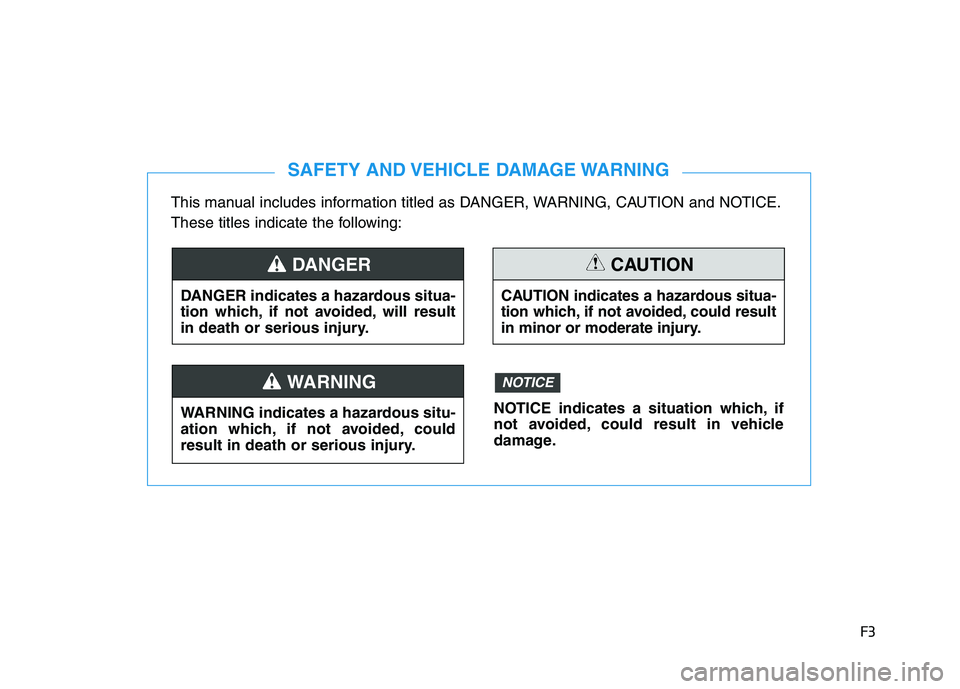
F3
This manual includes information titled as DANGER, WARNING, CAUTION and NOTICE.
These titles indicate the following:
SAFETY AND VEHICLE DAMAGE WARNING
DANGER indicates a hazardous situa-
tion which, if not avoided, will result
in death or serious injury.
DANGER
WARNING indicates a hazardous situ-
ation which, if not avoided, could
result in death or serious injury.
CAUTION indicates a hazardous situa-
tion which, if not avoided, could result
in minor or moderate injury.
CAUTION
NOTICE indicates a situation which, if
not avoided, could result in vehicle
damage.
NOTICEWARNING
Page 6 of 546
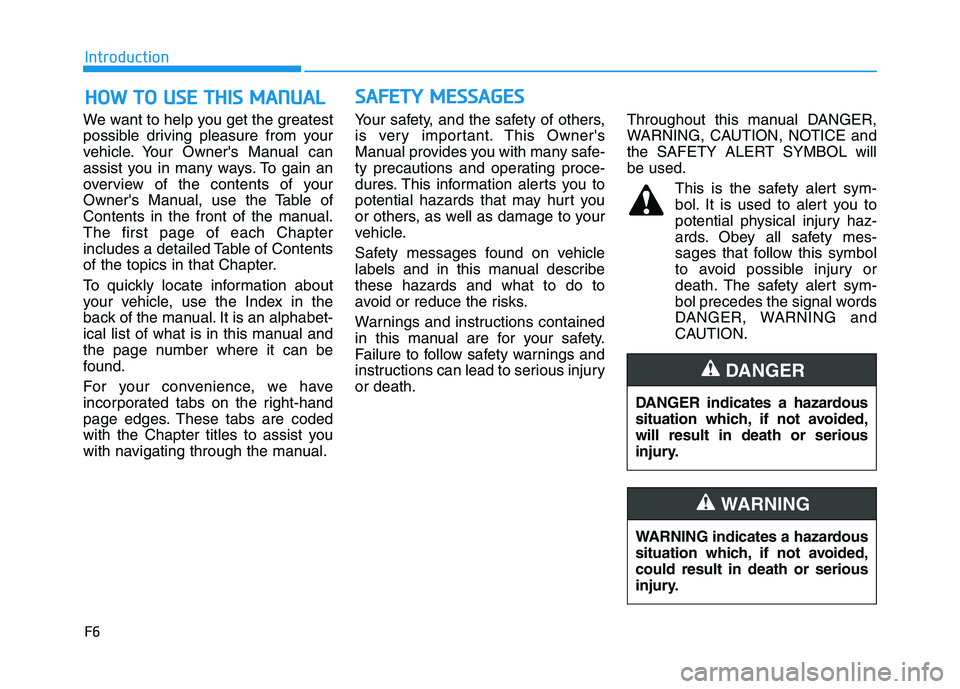
F6
Introduction
We want to help you get the greatest
possible driving pleasure from your
vehicle. Your Owner's Manual can
assist you in many ways. To gain an
overview of the contents of your
Owner's Manual, use the Table of
Contents in the front of the manual.The first page of each Chapter
includes a detailed Table of Contents
of the topics in that Chapter.
To quickly locate information about
your vehicle, use the Index in the
back of the manual. It is an alphabet-
ical list of what is in this manual and
the page number where it can be
found.
For your convenience, we have
incorporated tabs on the right-hand
page edges. These tabs are coded
with the Chapter titles to assist you
with navigating through the manual.Your safety, and the safety of others,
is very important. This Owner's
Manual provides you with many safe-
ty precautions and operating proce-
dures. This information alerts you to
potential hazards that may hurt you
or others, as well as damage to your
vehicle.
Safety messages found on vehicle
labels and in this manual describethese hazards and what to do to
avoid or reduce the risks.
Warnings and instructions contained
in this manual are for your safety.
Failure to follow safety warnings and
instructions can lead to serious injuryor death.
Throughout this manual DANGER,
WARNING, CAUTION, NOTICE and
the SAFETY ALERT SYMBOL willbe used.
This is the safety alert sym-bol. It is used to alert you to
potential physical injury haz-
ards. Obey all safety mes-
sages that follow this symbol
to avoid possible injury or
death. The safety alert sym-
bol precedes the signal words
DANGER, WARNING and
CAUTION.
HH OO WW TT OO UU SSEE TT HH IISS MM AANN UU AALL
DANGER indicates a hazardous
situation which, if not avoided,will result in death or serious
injury.
DANGER
WARNING indicates a hazardous
situation which, if not avoided,could result in death or serious
injury.
WARNING
SSAA FFEE TT YY MM EESSSSAA GG EESS
Page 10 of 546
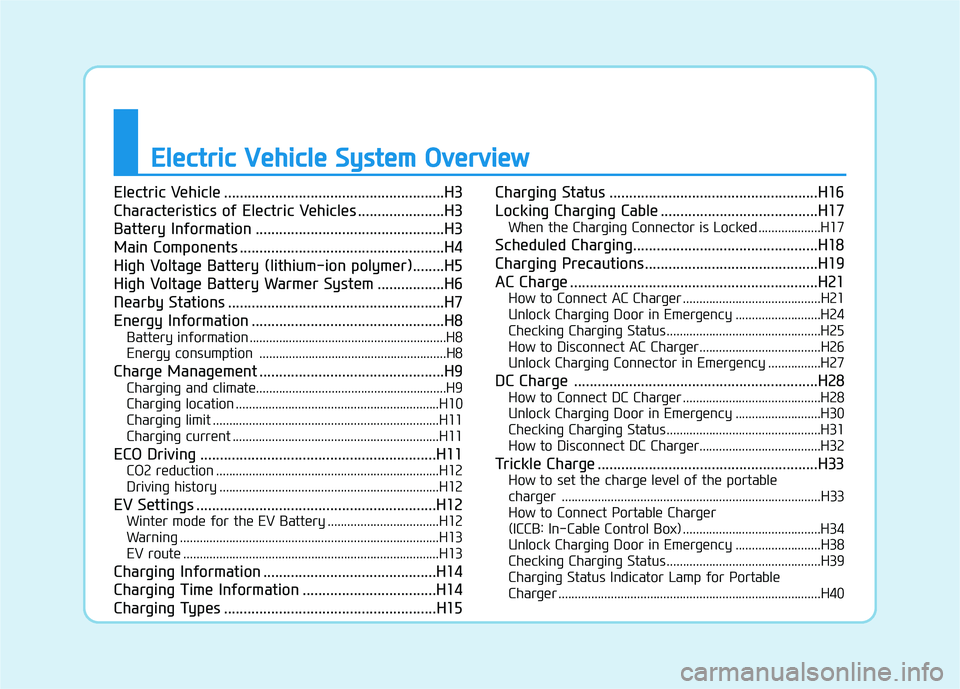
EEllee ccttrr iicc VV eehh iicc llee SS yyssttee mm OO vvee rrvv iiee ww
Electric Vehicle ........................................................H3
Characteristics of Electric Vehicles ......................H3
Battery Information ................................................H3
Main Components ....................................................H4
High Voltage Battery (lithium-ion polymer)........H5
High Voltage Battery Warmer System .................H6
Nearby Stations .......................................................H7
Energy Information .................................................H8
Battery information ............................................................H8
Energy consumption .........................................................H8
Charge Management ...............................................H9 Charging and climate..........................................................H9
Charging location ..............................................................H10
Charging limit .....................................................................H11
Charging current ...............................................................H11
ECO Driving ............................................................H11 CO2 reduction ....................................................................H12
Driving history ...................................................................H12
EV Settings .............................................................H12 Winter mode for the EV Battery ..................................H12
Warning ...............................................................................H13
EV route ..............................................................................H13
Charging Information ............................................H14
Charging Time Information ..................................H14
Charging Types ......................................................H15 Charging Status .....................................................H16
Locking Charging Cable ........................................H17
When the Charging Connector is Locked ...................H17
Scheduled Charging...............................................H18
Charging Precautions............................................H19
AC Charge ...............................................................H21 How to Connect AC Charger ..........................................H21
Unlock Charging Door in Emergency ..........................H24
Checking Charging Status ...............................................H25
How to Disconnect AC Charger.....................................H26
Unlock Charging Connector in Emergency ................H27
DC Charge ..............................................................H28 How to Connect DC Charger ..........................................H28
Unlock Charging Door in Emergency ..........................H30
Checking Charging Status ...............................................H31
How to Disconnect DC Charger.....................................H32
Trickle Charge ........................................................H33 How to set the charge level of the portable
charger ...............................................................................H33
How to Connect Portable Charger
(ICCB: In-Cable Control Box) ..........................................H34Unlock Charging Door in Emergency ..........................H38
Checking Charging Status ...............................................H39
Charging Status Indicator Lamp for Portable
Charger ................................................................................H40
Page 11 of 546
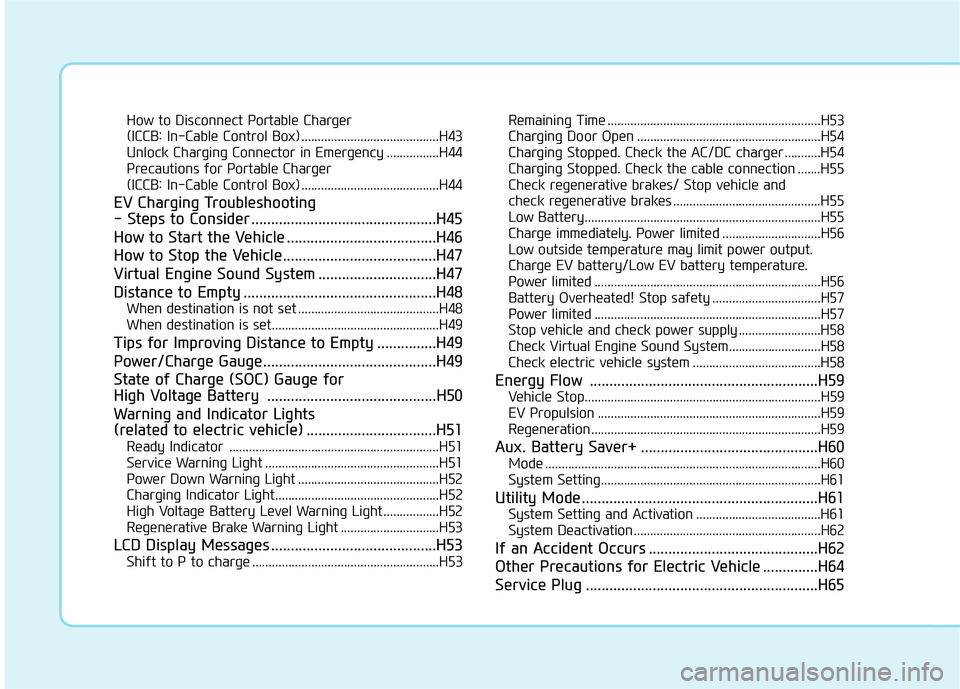
How to Disconnect Portable Charger
(ICCB: In-Cable Control Box) ..........................................H43Unlock Charging Connector in Emergency ................H44
Precautions for Portable Charger
(ICCB: In-Cable Control Box) ..........................................H44
EV Charging Troubleshooting
- Steps to Consider ...............................................H45
How to Start the Vehicle ......................................H46
How to Stop the Vehicle.......................................H47
Virtual Engine Sound System ..............................H47
Distance to Empty .................................................H48 When destination is not set ...........................................H48
When destination is set...................................................H49
Tips for Improving Distance to Empty ...............H49
Power/Charge Gauge............................................H49
State of Charge (SOC) Gauge for
High Voltage Battery ...........................................H50
Warning and Indicator Lights
(related to electric vehicle) .................................H51 Ready Indicator ................................................................H51
Service Warning Light .....................................................H51
Power Down Warning Light ...........................................H52
Charging Indicator Light..................................................H52
High Voltage Battery Level Warning Light .................H52
Regenerative Brake Warning Light ..............................H53
LCD Display Messages ..........................................H53 Shift to P to charge .........................................................H53 Remaining Time .................................................................H53
Charging Door Open ........................................................H54
Charging Stopped. Check the AC/DC charger ...........H54
Charging Stopped. Check the cable connection .......H55
Check regenerative brakes/ Stop vehicle and
check regenerative brakes .............................................H55 Low Battery........................................................................H55
Charge immediately. Power limited ..............................H56
Low outside temperature may limit power output.
Charge EV battery/Low EV battery temperature.
Power limited .....................................................................H56 Battery Overheated! Stop safety .................................H57
Power limited .....................................................................H57
Stop vehicle and check power supply .........................H58
Check Virtual Engine Sound System............................H58
Check electric vehicle system .......................................H58
Energy Flow ..........................................................H59 Vehicle Stop........................................................................H59
EV Propulsion ....................................................................H59
Regeneration ......................................................................H59
Aux. Battery Saver+ .............................................H60 Mode ....................................................................................H60
System Setting...................................................................H61
Utility Mode ............................................................H61 System Setting and Activation ......................................H61
System Deactivation.........................................................H62
If an Accident Occurs ...........................................H62
Other Precautions for Electric Vehicle ..............H64
Service Plug ...........................................................H65
Page 13 of 546
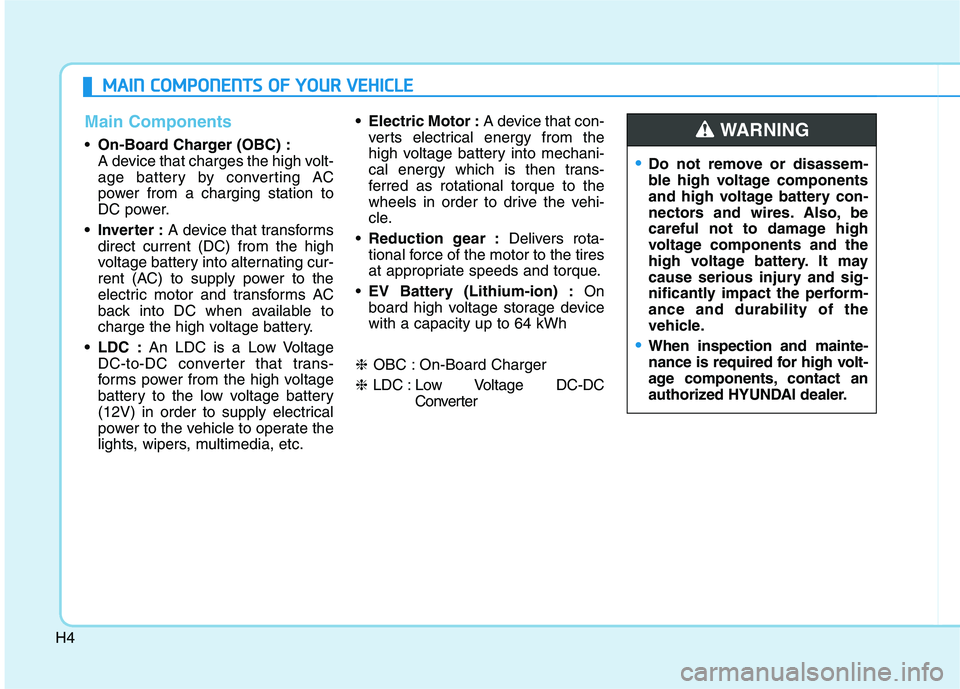
H4
MMAAIINN CC OO MM PPOO NNEENN TTSS OO FF YY OO UURR VV EEHH IICC LLEE
Main Components
On-Board Charger (OBC) :
A device that charges the high volt-
age battery by converting AC
power from a charging station to
DC power.
• Inverter : A device that transforms
direct current (DC) from the high
voltage battery into alternating cur-
rent (AC) to supply power to the
electric motor and transforms AC
back into DC when available to
charge the high voltage battery.
LDC : An LDC is a Low Voltage
DC-to-DC converter that trans-
forms power from the high voltage
battery to the low voltage battery
(12V) in order to supply electrical
power to the vehicle to operate the
lights, wipers, multimedia, etc. Electric Motor :
A device that con-
verts electrical energy from the
high voltage battery into mechani-
cal energy which is then trans-
ferred as rotational torque to the
wheels in order to drive the vehi-
cle.
Reduction gear : Delivers rota-
tional force of the motor to the tires
at appropriate speeds and torque.
EV Battery (Lithium-ion) : On
board high voltage storage devicewith a capacity up to 64 kWh
❈ OBC : On-Board Charger
❈ LDC : Low Voltage DC-DC
Converter
Do not remove or disassem-
ble high voltage components
and high voltage battery con-
nectors and wires. Also, be
careful not to damage high
voltage components and the
high voltage battery. It may
cause serious injury and sig-
nificantly impact the perform-ance and durability of the
vehicle.
When inspection and mainte-
nance is required for high volt-
age components, contact an
authorized HYUNDAI dealer.
WARNING
Page 21 of 546
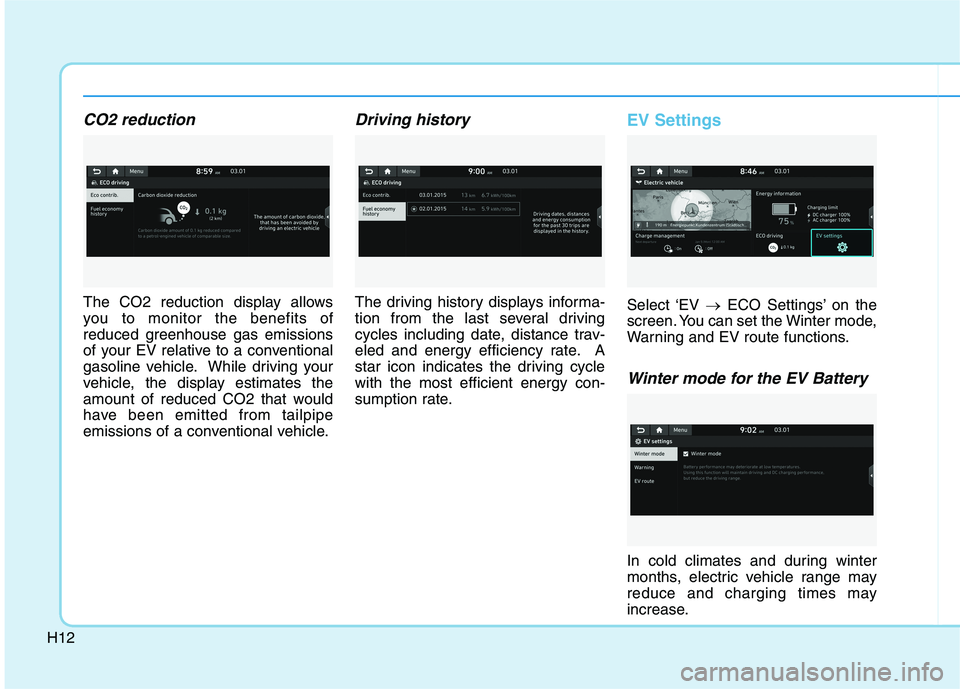
H12
CO2 reduction
The CO2 reduction display allows
you to monitor the benefits of
reduced greenhouse gas emissions
of your EV relative to a conventional
gasoline vehicle. While driving your
vehicle, the display estimates the
amount of reduced CO2 that would
have been emitted from tailpipe
emissions of a conventional vehicle.
Driving history
The driving history displays informa-
tion from the last several driving
cycles including date, distance trav-
eled and energy efficiency rate. A
star icon indicates the driving cyclewith the most efficient energy con-
sumption rate.
EV Settings
Select ‘EV �ECO Settings’ on the
screen. You can set the Winter mode,
Warning and EV route functions.
Winter mode for the EV Battery
In cold climates and during winter
months, electric vehicle range may
reduce and charging times may
increase.
Page 22 of 546
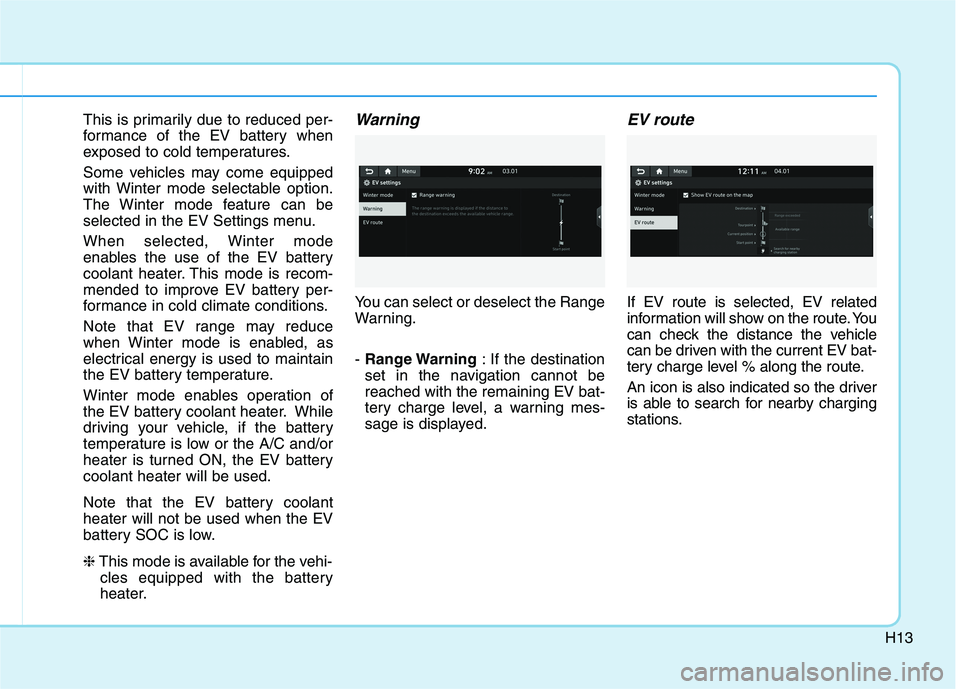
H13
This is primarily due to reduced per-
formance of the EV battery when
exposed to cold temperatures.
Some vehicles may come equipped
with Winter mode selectable option.
The Winter mode feature can be
selected in the EV Settings menu.
When selected, Winter mode
enables the use of the EV battery
coolant heater. This mode is recom-
mended to improve EV battery per-
formance in cold climate conditions.
Note that EV range may reduce
when Winter mode is enabled, as
electrical energy is used to maintain
the EV battery temperature.
Winter mode enables operation of
the EV battery coolant heater. While
driving your vehicle, if the battery
temperature is low or the A/C and/or
heater is turned ON, the EV batterycoolant heater will be used.
Note that the EV battery coolant heater will not be used when the EV
battery SOC is low. ❈This mode is available for the vehi-
cles equipped with the battery
heater.Warning
You can select or deselect the Range
Warning. - Range Warning : If the destination
set in the navigation cannot be reached with the remaining EV bat-
tery charge level, a warning mes-
sage is displayed.
EV route
If EV route is selected, EV related
information will show on the route. You
can check the distance the vehicle
can be driven with the current EV bat-
tery charge level % along the route.
An icon is also indicated so the driver
is able to search for nearby charging
stations.
Page 28 of 546
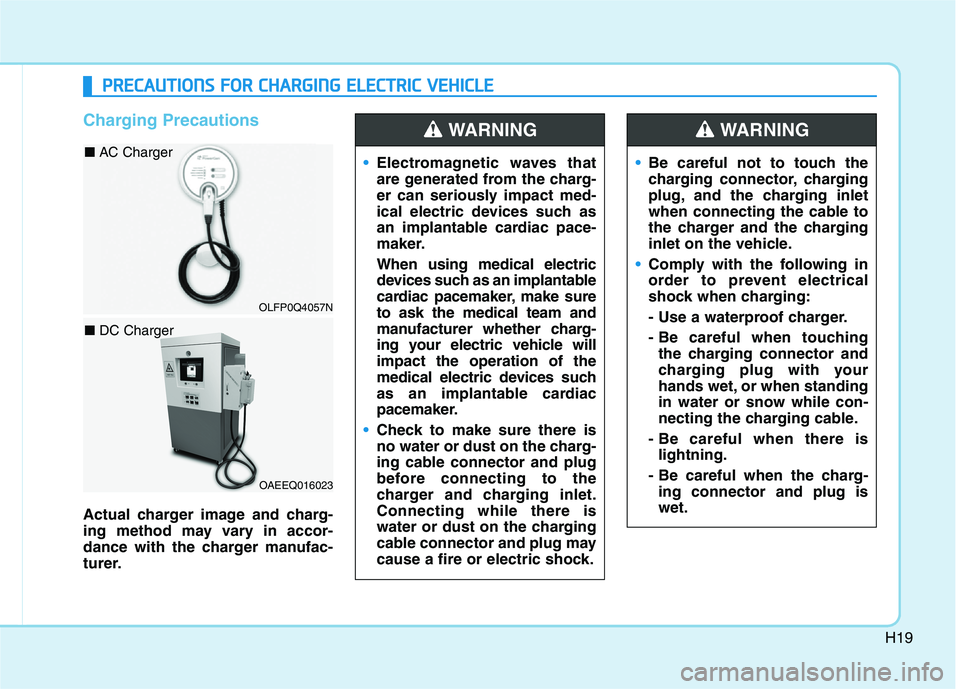
H19
Charging Precautions
Actual charger image and charg-
ing method may vary in accor-
dance with the charger manufac-
turer.
Electromagnetic waves that
are generated from the charg-
er can seriously impact med-
ical electric devices such as
an implantable cardiac pace-
maker. When using medical electric
devices such as an implantable
cardiac pacemaker, make sureto ask the medical team and
manufacturer whether charg-
ing your electric vehicle willimpact the operation of the
medical electric devices such
as an implantable cardiac
pacemaker.
Check to make sure there is
no water or dust on the charg-
ing cable connector and plug
before connecting to the
charger and charging inlet.Connecting while there is
water or dust on the charging
cable connector and plug may
cause a fire or electric shock.
WARNING
Be careful not to touch the
charging connector, charging
plug, and the charging inlet
when connecting the cable to
the charger and the charging
inlet on the vehicle.
Comply with the following in
order to prevent electrical
shock when charging:
- Use a waterproof charger.
- Be careful when touchingthe charging connector and
charging plug with your
hands wet, or when standing
in water or snow while con-
necting the charging cable.
- Be careful when there is lightning.
- Be careful when the charg- ing connector and plug iswet.
WARNING
PP RR EECCAA UU TTIIOO NNSS FF OO RR CC HH AARRGG IINN GG EE LLEE CCTT RR IICC VV EEHH IICC LLEE
OAEEQ016023
■
DC Charger
OLFP0Q4057N
■
AC Charger